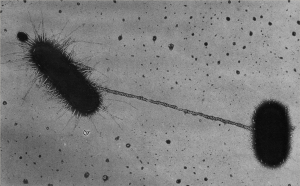Enterohemorrhagic Escherichia coli (EHEC) O157:H7 strain EDL933 harbors multiple prophage-associated open reading frames (ORFs) in its genome which are highly homologous to the chromosomal nanS gene. The latter is part of the nanCMS operon, which is present in most E. coli strains and encodes an esterase which is responsible for the monodeacetylation of 5-N-acetyl-9-O-acetyl neuraminic acid (Neu5,9Ac2). Whereas one prophage-borne ORF (z1466) has been characterized in previous studies, the functions of the other nanS-homologous ORFs are unknown.
 In the current study, the nanS-homologous ORFs of EDL933 were initially studied in silico. Due to their homology to the chromosomal nanS gene and their location in prophage genomes, we designated them nanS-p and numbered the different nanS-p alleles consecutively from 1 to 10. The two alleles nanS-p2 and nanS-p4 were selected for production of recombinant proteins, their enzymatic activities were investigated, and differences in their temperature optima were found. Furthermore, a function of these enzymes in substrate utilization could be demonstrated using an E. coli C600ΔnanS mutant in a growth medium with Neu5,9Ac2 as the carbon source and supplementation with the different recombinant NanS-p proteins. Moreover, generation of sequential deletions of all nanS-p alleles in strain EDL933 and subsequent growth experiments demonstrated a gene dose effect on the utilization of Neu5,9Ac2. Since Neu5,9Ac2 is an important component of human and animal gut mucus and since the nutrient availability in the large intestine is limited, we hypothesize that the presence of multiple Neu5,9Ac2 esterases provides them a nutrient supply under certain conditions in the large intestine, even if particular prophages are lost.
In the current study, the nanS-homologous ORFs of EDL933 were initially studied in silico. Due to their homology to the chromosomal nanS gene and their location in prophage genomes, we designated them nanS-p and numbered the different nanS-p alleles consecutively from 1 to 10. The two alleles nanS-p2 and nanS-p4 were selected for production of recombinant proteins, their enzymatic activities were investigated, and differences in their temperature optima were found. Furthermore, a function of these enzymes in substrate utilization could be demonstrated using an E. coli C600ΔnanS mutant in a growth medium with Neu5,9Ac2 as the carbon source and supplementation with the different recombinant NanS-p proteins. Moreover, generation of sequential deletions of all nanS-p alleles in strain EDL933 and subsequent growth experiments demonstrated a gene dose effect on the utilization of Neu5,9Ac2. Since Neu5,9Ac2 is an important component of human and animal gut mucus and since the nutrient availability in the large intestine is limited, we hypothesize that the presence of multiple Neu5,9Ac2 esterases provides them a nutrient supply under certain conditions in the large intestine, even if particular prophages are lost.
Importance
In this study, a group of homologous prophage-borne nanS-p alleles and two of the corresponding enzymes of enterohemorrhagic E. coli (EHEC) O157:H7 strain EDL933 that may be important to provide alternative genes for substrate utilization were characterized.
Escherichia coli O157:H7 strain EDL933 harbors multiple functional prophage-associated genes necessary for the utilization of 5-N-acetyl-9-O-acetyl neuraminic acid as a growth substrate
Appl. Environ. Microbiol. October 2016 vol. 82 no. 19 5940-5950, posted online 29 July 2016, doi: 10.1128/AEM.01671-16
Nadja Saile, Anja Voigt, Sarah Kessler, Timo Stressler, Jochen Klumpp, Lutz Fischer and Herbert Schmidt


